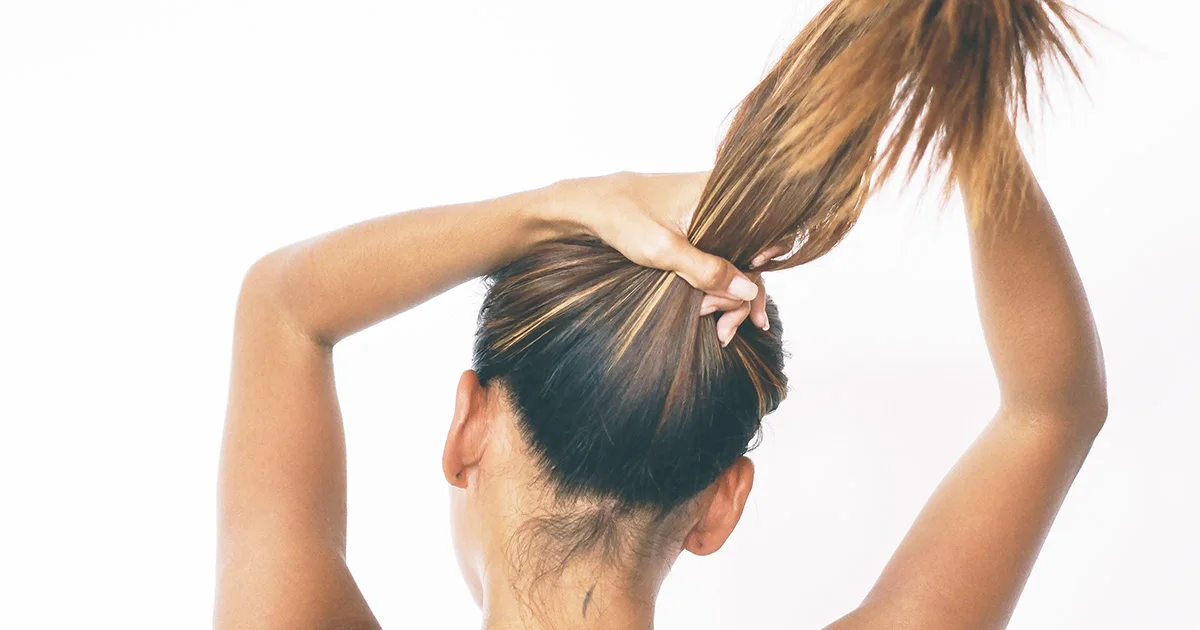Here's what we'll cover
Here's what we'll cover
If you’ve noticed signs of a fungal infection on your scalp—such as itchy or scaly patches or even bald spots—you may be in a rush to get some antifungal cream for your scalp. That’s a good instinct. Scalp fungal infections are common and treatable, but it’s important to act quickly to relieve your symptoms and prevent the infection from spreading (Al Aboud, 2021).
Read on as we explain what causes scalp fungus and your treatment options, including oral medications and topical shampoos.
What causes scalp fungus?
Scalp fungus, also known as ringworm or tinea capitis, is caused by tiny fungi called dermatophytes. These fungi can penetrate the hair follicles, root, and hair shaft.
Coming into contact with another person, animal, or item with ringworm increases your risk of getting fungus on your scalp. For example, you may pet a dog with ringworm and then touch your scalp, or you could borrow a hairbrush from an infected person, both of which can spread the infection to your scalp. Scalp fungal infections spread more easily in hot, humid environments where dermatophytes thrive, like a school locker room or shared bathroom (Al Aboud, 2021).
Could your itchy scalp be ringworm?
Ringworm is a common cause of itchy scalp. It’s a fungal skin infection characterized by small, circular white or gray patches of itchy, scaly skin, surrounded by raised reddish borders. Ringworm gets its name from these ring-like borders; it doesn’t involve a worm (Leung, 2020; Al Aboud, 2021).
When you have scalp ringworm, your hair may break off due to the infection, causing a bald spot with scaly red skin. You may also see tiny black dots on the bald patch where this happened or notice dandruff. If the ringworm infection is left untreated, these bald spots may continue to grow. Brittle hair texture is another symptom of hair fungus. In more severe cases of scalp ringworm, you may notice areas of swelling that drain pus, crust over, and go bald (Leung, 2020; Al Aboud, 2021).
Tinea capitis is the name for ringworm on the scalp and hair shafts (Al Aboud, 2021). It’s related to other common fungal conditions like ringworm of the body (tinea corporis), athlete’s foot (tinea pedis), and jock itch (tinea cruris) (Yee, 2021).
How do you get ringworm?
Ringworm is a common, contagious condition that spreads easily. You can get it through skin-to-skin contact with another person or animal with ringworm or by using something an infected person has used on your scalp, such as a hat, hairbrush, comb, pillow, or towel (Leung, 2020; Al Aboud, 2021).
Ringworm can affect anyone at any age, but it is more common among children, particularly between the ages of three and seven (Leung, 2020; Al Aboud, 2021). Up to 25% of elementary school-aged children experience a ringworm infection at some point (Alkeswani, 2019; Hay, 2018).
A healthcare professional can diagnose scalp ringworm with a visual exam and a small hair sample. They may ask about your other symptoms, if you’ve been in contact with pets or people with ringworm, or if any cases have been reported in your school or workplace (Ely, 2014; Al Aboud, 2021).
Scalp fungus treatment
Scalp ringworm treatment typically includes a mix of oral antifungal medication and medicated shampoo (Leung, 2020). It’s also a good idea to wash items that touch your hair—such as clothing, bedding, pillowcases, and towels—in hot water. And you’ll want to disinfect or completely replace hairbrushes, combs, or any other items you’ve used on your head (Al Aboud, 2021).
Antifungal medication for ringworm
Oral antifungals are the primary treatment for scalp ringworm. These medications are designed to cure the infection by killing the fungi causing it. They include griseofulvin, terbinafine, itraconazole, or fluconazole (Leung, 2020; Al Aboud, 2021).
Your healthcare provider may prescribe different antifungals depending on their availability, the specific fungi that have infected your hair shaft, or your age (Maxfield, 2021; Alkeswani, 2019). For example, griseofulvin is the most common antifungal prescribed to children (Olson, 2021; Chen, 2016). Steroids may also be recommended in more severe cases of scalp fungus (Al Aboud, 2021).
Depending on the medication, you take these medications orally for anywhere from four to twelve weeks (Al Aboud, 2021; Alkeswani, 2019). Side effects are typically mild but may include (Sinawe, 2021; Maxfield, 2021; Olson, 2021):
Constipation
Changes in taste
Diarrhea
Dry mouth
Headache
Nausea
Upset stomach
Stomach pain or cramps
Rash
Weight loss
Vomiting
Antifungal shampoo for ringworm
Your healthcare provider may also recommend using an antifungal shampoo or ointment. It’s important to note that antifungal shampoos are not effective in curing scalp fungus on their own. They can only stop the infection from spreading and reduce your risk of spreading it to other people. To kill the infection, you must take oral antifungal medication (Al Aboud, 2021).
Antifungal creams cannot kill the fungi because they don’t reach the root of the hair follicles (Ely, 2014; Leung, 2020). However, they may increase the cure rate for ringworm (Leung, 2020). For example, studies show that oral griseofulvin works more effectively when combined with selenium sulfide shampoo (Olson, 2021).
Antifungal shampoo for ringworm may be prescribed for two to four weeks (Al Aboud, 2021). These shampoos contain antifungal ingredients like ketoconazole, selenium sulfide, or ciclopirox (Ely, 2014; Alkeswani, 2019). A few times a week, you’ll rub the shampoo into a lather and apply it to your hair. Leave it on for the recommended amount of time, and then rinse and fully wash your hands (Sinawe, 2021; Hay, 2018). Anti-dandruff shampoos may be recommended for other symptoms, such as dandruff (Chen, 2016).
There are over-the-counter shampoos that contain ketoconazole or selenium sulfide, like Nizoral. While these may be a good option for people you’ve been in close contact with, they are typically not strong enough to stop the spread of a fungal infection. Prescription-strength options are best (Sinawe, 2021; Alkeswani, 2019).
Does tinea capitis cause hair loss?
Generally, any hair loss associated with tinea capitis is temporary and resolves once the infection is treated. However, left untreated and in some severe cases, tinea capitis may cause bald patches or scarring on the scalp. In severe cases of inflammation, people develop kerion. These are soft, pronounced areas of swelling that drain pus and have thick, yellow crusts. The hair falls out on its own or can be pulled easily. Cases of tinea capitis with kerion may lead to permanent scarring or hair loss (Al Aboud, 2021).
How to grow hair back after a scalp fungal infection
The best thing you can do to grow your hair back after a scalp fungal infection is to follow the treatment plan recommended by your healthcare provider. Don’t stop taking any medication early, as the ringworm could still be there even if you can’t see it (Al Aboud, 2021).
Ringworm takes time to heal—it can take at least a month or longer—so be patient. Antifungal treatment for ringworm is generally effective, and after treatment is complete, the infection goes away, and your hair grows back. In the meantime, don’t share personal items with others and avoid close personal contact to prevent spread (Al Aboud, 2021; Ely, 2014).
To prevent scalp ringworm, know how to recognize the signs in yourself and others in your household, including any children and pets. Avoid using shared items, like hair brushes or towels (Al Aboud, 2021). And if you think you have it, talk to a healthcare professional quickly. That’s the best way to prevent it from spreading and get relief from your symptoms as soon as possible!
DISCLAIMER
If you have any medical questions or concerns, please talk to your healthcare provider. The articles on Health Guide are underpinned by peer-reviewed research and information drawn from medical societies and governmental agencies. However, they are not a substitute for professional medical advice, diagnosis, or treatment.
Al Aboud, A. M. & Crane, J. S. (2021). Tinea capitis. StatPearls . Retrieved on May 9, 2022 from https://pubmed.ncbi.nlm.nih.gov/30725594/
Alkeswani, A., Cantrell, W., & Elewski, B. (2019). Treatment of tinea capitis. Skin Appendage Disorders , 5 (4), 201–210. doi:10.1159/000495909. Retrieved from https://www.ncbi.nlm.nih.gov/pmc/articles/PMC6615323/
Chen, X., Jiang, X., Yang, M., et al. (2016). Systemic antifungal therapy for tinea capitis in children. The Cochrane Database of Systematic Reviews , 2016 (5), CD004685. doi:10.1002/14651858.CD004685.pub3. Retrieved from https://pubmed.ncbi.nlm.nih.gov/27169520/
Ely, J. W., Rosenfeld, S., & Seabury Stone, M. (2014). Diagnosis and management of tinea infections. American Family Physician , 90 (10), 702–710. Retrieved from https://pubmed.ncbi.nlm.nih.gov/25403034/
Gupta, A. K., Mays, R. R., Versteeg, S. G., et al. (2018). Tinea capitis in children: a systematic review of management. Journal of the European Academy of Dermatology and Venereology , 32 (12), 2264–2274. doi:10.1111/jdv.15088. Retrieved from https://pubmed.ncbi.nlm.nih.gov/29797669/
Hay, R. (2018). Therapy of skin, hair and nail fungal infections. Journal of Fungi (Basel, Switzerland) , 4 (3), 99. doi:10.3390/jof4030099. Retrieved from https://pubmed.ncbi.nlm.nih.gov/30127244/
Leung, A., Hon, K. L., Leong, K. F., et al. (2020). Tinea capitis: An updated review. Recent Patents on Inflammation & Allergy Drug Discovery , 14 (1), 58–68. doi:10.2174/1872213X14666200106145624. Retrieved from https://pubmed.ncbi.nlm.nih.gov/31906842/
Maxfield, L., Preuss, C. V., & Bermudez, R. (2021). Terbinafine. StatPearls . Retrieved on May 9, 2022 from https://pubmed.ncbi.nlm.nih.gov/31424802/
Olson, J. M. & Troxell, T. (2021). Griseofulvin. StatPearls . Retrieved on May 9, 2022 from https://pubmed.ncbi.nlm.nih.gov/30726008/
Shemer, A., Plotnik, I. B., Davidovici, B., et al. (2013). Treatment of tinea capitis - griseofulvin versus fluconazole - a comparative study. Journal of the German Society of Dermatology , 11 (8), 737–742. doi:10.1111/ddg.12095. Retrieved from https://pubmed.ncbi.nlm.nih.gov/23575220/
Sinawe, H. & Casadesus, D. (2021). Ketoconazole. StatPearls . Retrieved on May 9, 2022 from https://pubmed.ncbi.nlm.nih.gov/32644647/
Yee, G. & Al Aboud, A. M. (2021). Tinea corporis. StatPearls . Retrieved on May 9, 2022 from https://pubmed.ncbi.nlm.nih.gov/31335080/










